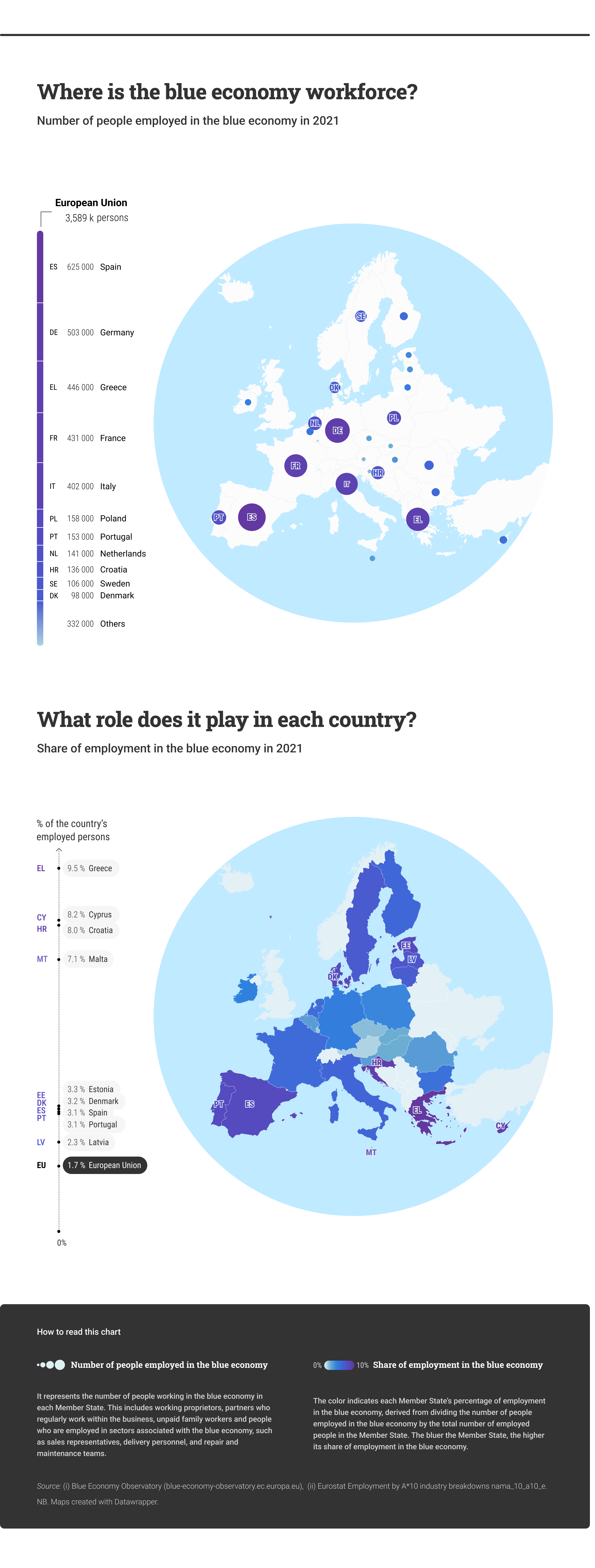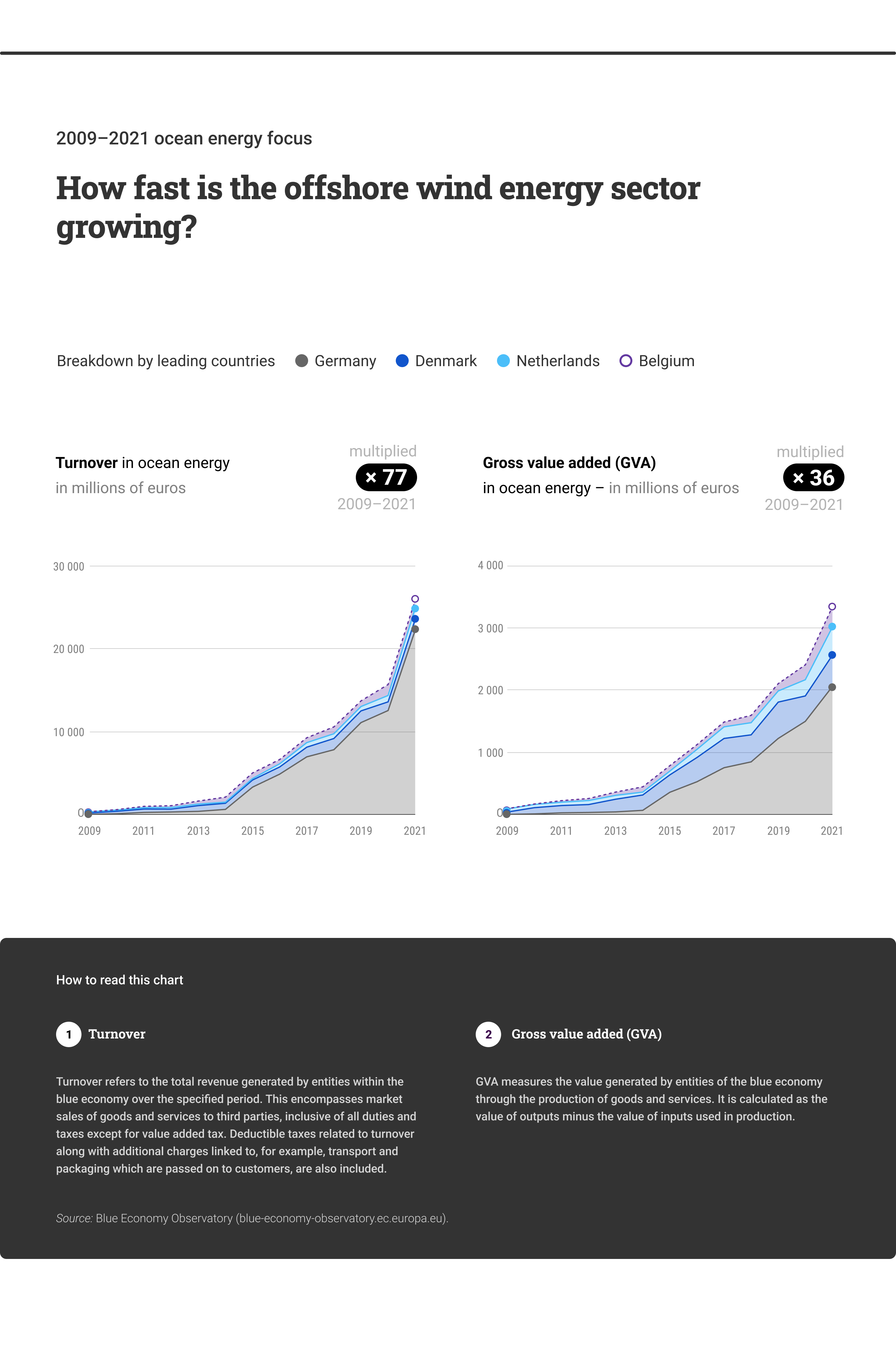Getting to know the blue economy through open data
Open datasets provide insights into the importance of maritime affairs and fisheries and for the European Union
The blue economy has been defined by the World Bank as the ‘sustainable use of ocean resources for economic growth, improved livelihoods, and jobs while preserving the health of ocean ecosystem.’ The blue economy of the European Union (EU) encompasses every industry and sector linked to oceans, seas and coasts, whether they operate directly within the marine environment or on land. The established sectors include marine living resources (such as fishing and aquaculture), marine non-living resources (mining), marine renewable energy, port activities (such as cargo and passenger services), shipbuilding and repair, maritime transport and coastal tourism. Given that the EU, including its outlying regions, claims the world’s largest maritime territory, the blue economy holds significant importance for the overall EU economy. However, the relevance of the domain varies significantly across Member States, with bigger coastal nations naturally holding a more substantial stake.
This data story uses open data to underscore the importance of the blue economy and to paint a comprehensive picture of the socioeconomic size of the EU’s maritime affairs. The analysis first provides an overview of the size of the blue economy; it then focuses more specifically on one of the most important sectors, coastal tourism; finally, it highlights the growing importance of the renewable offshore wind energy sector.
An overview of the size of the EU blue economy
Open data on employment provides interesting insights into the collective size of the blue economy and the importance it has in different EU Member States. Figure 1 illustrates the number of employees in the blue economy both in absolute terms and as percentages of each country’s workforce in 2021. In that year, the blue economy’s workforce in the EU amounted to nearly 3.6 million employees or 1.7 % of the total EU workforce. As highlighted in the EU Blue Economy Report 2024, this marked a significant increase of 17 % with respect to 2020. The blue economy, in fact, had been profoundly impacted by the COVID-19 pandemic and saw a decrease from 4.4 million employees in 2019 to 3.1 million in 2020, but it began to recover by 2021.
In absolute terms, some of the EU’s largest countries by population lead the ranking, with Greece being an exception due to its smaller population size. Spain is at the forefront, counting over 625 000 employees, followed by Germany, Greece, France and Italy, each employing between 400 000 and 500 000 workers. However, when considering the proportion of domestic employment in 2021, the picture changes. Greece leads with 9.5 % of its workforce employed in the blue economy, followed by Cyprus and Croatia with around 8 %, and Malta and Estonia with 7.1 % and 3.3 %, respectively. The significant share of domestic employment in Greece aligns with its third-place position in absolute employment figures, distinguishing Greece as the sole country featured in the top three across both rankings. Check out how many employees work in the blue economy in your country on the interactive dashboard!

Figure 1: Size of the workforce employed in the blue economy (Source: data.europa.eu, Blue Economy Observatory)
An open data perspective on coastal tourism
The EU’s coastal regions stand out as preferred choices for both European and global tourists. As indicated by the open data in Figure 2, in normal years, coastal tourism is the largest and fastest-growing sector within the EU blue economy, particularly in terms of employment opportunities. Especially for certain countries, like the southern European ones, seasonal coastal tourism generates a significant portion of their total national income and employment.
However, the sector experienced some of the most severe impacts across the entire economy during the COVID-19 pandemic, primarily due to the introduction of global travel restrictions. In 2020, coastal tourism experienced a staggering reduction in turnover, leading the sector’s turnover size to fall behind maritime transport and living resources. However, in 2021, coastal tourism jumped back, surpassing living resources and reaching a turnover of EUR 140 billion. Figure 2 shows that in 2021, Spain accounted for 22 % of the total EU coastal tourism turnover, followed by France with 18 %, Italy with 12 %, and Greece with 10 %.
With regard to employment, the sector experienced a 40 % decrease in 2020, but the recovery that followed raised employment back to 1.91 million in 2021, still significantly lower than its 2018 high of 2.86 million. In 2021, Spain accounted for 22 % of EU jobs in coastal tourism, followed by Greece with 19 % (a sharp increase from 2020’s 11 %), France with 13 %, and Italy with 9 %. It is worth noting that, despite the significant downturn of 2019 and 2020, coastal tourism maintained its status as the leading contributor to employment. In 2021, the sector accounted for nearly 54 % of jobs in the blue economy.
Figure 2 shows the evolution of both employment and turnover between 2009 and 2021, and the trend in 2021 highlights the quick recovery of tourism from the COVID-19 pandemic. Continue to explore coastal tourism and its recovery through open data here.

Figure 2: Size of workforce and turnover of coastal tourism (Source: data.europa.eu, Blue Economy Observatory)
An open data perspective on renewable offshore wind energy
Marine renewable energy represents an incredible opportunity to green the EU economy and contribute to the 2050 objectives of the European Green Deal. Marine renewable energy is a major source of sustainable energy that is generated from offshore wind farms and other ocean energy technologies. The Green Deal plans to escalate offshore wind energy deployment to cover approximately 30 % of the EU’s future electricity supply. Overall, the sector generated EUR 3.34 billion in gross value added (GVA, meaning value generated by entities of the blue economy through the production of goods and services) in 2021, which represents a 39 % increase compared with 2020 and a 346 % increase from 2015.
The overarching goal is to establish offshore wind energy as a pivotal contributor to Europe’s journey towards carbon neutrality, and open data is crucial to tracking these steps. Figure 3 shows that the sector has experienced a steep increase, especially after 2014. The visual aims to highlight the significant growth in GVA and turnover from 2009 to 2021. Notably, in 2021, turnover grew 77-fold compared to its initial value in 2009; while GVA increased 36-fold. This signals incredible progress that sees Belgium leading the ranking, followed by the Netherlands, Denmark and Germany. Check out how other EU Member States are doing on the dashboard.

Figure 3: Turnover and GVA of the offshore wind energy sector (Source: data.europa.eu, Blue Economy Observatory)
Conclusion
This story delves into various aspects of the EU blue economy, analysing open data on key economic indicators. Open data sheds light on the main actors in the blue economy in terms of employment. While the bigger Member States employ the majority of workers in absolute terms, smaller ones such as Estonia, Greece, Croatia, Cyprus and Malta present the highest relative employment rates. Tourism emerges as a pivotal sector within the blue economy, and open data provides evidence of the substantial impact of the COVID-19 pandemic on the sector, but it also highlights the recovery starting in 2021 in terms of both employment and turnover. Open data also emphasises the expansion of the offshore wind sector, especially given the increasing importance of sustainable renewable sources in the EU’s energy mix. Data indicates that turnover of the offshore wind energy sector grew 77-fold in 2021 compared to its initial value in 2009, while GVA increased 36-fold.
Open data is crucial for understanding the dynamics of different economic sectors and guiding data-based policymaking. Do you want to explore the other sectors of the blue economy? You can access numerous open datasets on data.europa.eu. Stay updated on our upcoming data stories and webinars by subscribing to our newsletter and following data.europa.eu on social media.
